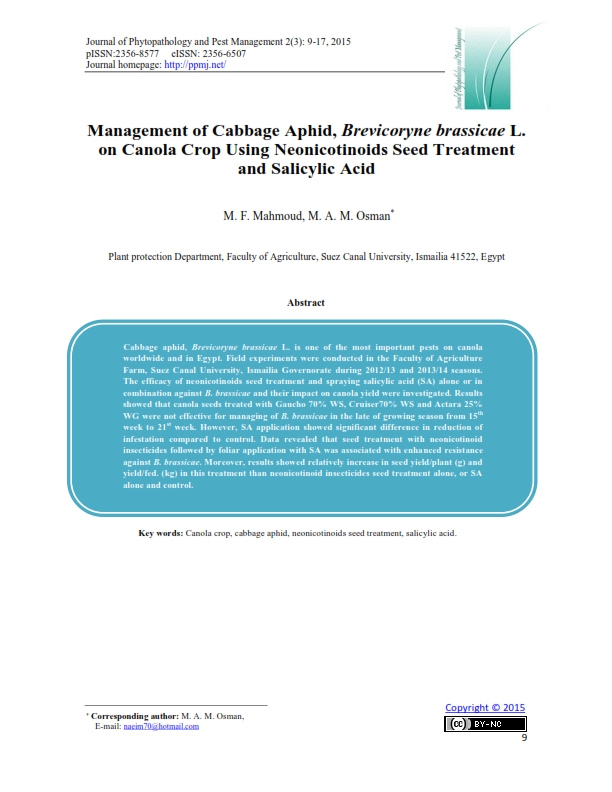Management of Cabbage Aphid, Brevicoryne brassicae L. on Canola Crop Using Neonicotinoids Seed Treatment and Salicylic Acid
Keywords:
Canola crop, cabbage aphid, neonicotinoids seed treatment, salicylic acid.Abstract
Cabbage aphid, Brevicoryne brassicae L. is one of the most important pests on canola worldwide and in Egypt. Field experiments were conducted in the Faculty of Agriculture Farm, Suez Canal University, Ismailia Governorate during 2012/13 and 2013/14 seasons. The efficacy of neonicotinoids seed treatment and spraying salicylic acid (SA) alone or in combination against B. brassicae and their impact on canola yield were investigated. Results showed that canola seeds treated with Gaucho 70% WS, Cruiser70% WS and Actara 25% WG were not effective for managing of B. brassicae in the late of growing season from 15th week to 21st week. However, SA application showed significant difference in reduction of infestation compared to control. Data revealed that seed treatment with neonicotinoid insecticides followed by foliar application with SA was associated with enhanced resistance against B. brassicae. Moreover, results showed relatively increase in seed yield/plant (g) and yield/fed. (kg) in this treatment than neonicotinoid insecticides seed treatment alone, or SA alone and control.
Â
Metrics

Published
How to Cite
Issue
Section
License
Authors who publish with Journal of Phytopathology and Disease Management agree to the following terms:
- Authors retain copyright and grant the journal right of first publication with the work simultaneously licensed under a Creative Commons Attribution License that allows others to share the work with an acknowledgement of the work's authorship and initial publication in this journal.
- Authors retain copyright and grant the journal right of first publication with the work simultaneously licensed under the Creative Commons Attribution-Non Commercial License (CC BY-NC). This allows others to share the work with an acknowledgement of the work's authorship and initial publication in this journal.
- Archives of Agricultural Sciences Journal is an Open Access Journal, and articles published are distributed under the terms of the Creative Commons Attribution-Non Commercial License (CC BY-NC). Readers may copy, distribute, and display the work for non commercial purposes with the proper citation of the original work. However, the journal retains the right to exploit subsidiary rights on behalf of the authors.
- Authors are able to enter into separate, additional contractural arrangements for the non-exclusive distribution of the journal's published version of the work (e.g. post it to an institutional repository or publish it in a book), with an acknowledgement of its initial publication in this journal.
- Authors are permitted and encouraged to post their work online (e.g., in institutional repositories or on their website) prior to and during the submission process with full disclosure to the journal, as it can lead to productive exchanges, as well as earlier and greater citation of published work. Following publication in Archives of Agricultural Sciences Journal, the author should update the repository, and include a citation and link to the published work.
Click here for more information on Licensing policy
.png)




